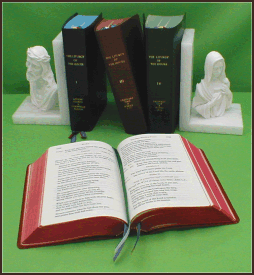|
Allow 1-3 weeks for delivery within the 50 United Stat
The Liturgy of the Hours
The Liturgy of the Hours or Divine Office has been commonly known as the breviary or priest's daily prayerbook. Before the desired reform of Vatican II, it was said by priests and religious but principally as a private prayer. The liturgical reform of Vatican II has restored the Divine Office to its original purpose as the prayer of the entire Church.
Although bishops, priests, deacons, and religious have an obligation to pray the Office, the reform has attempted to make it accessible to others by simplifying its structure to give greater emphasis to the reading of the word of God and the praying of the psalms. Since the communal nature of the Liturgy of the Hours has been emphasized again, wherever possible encouragement should be given at least to the celebration of morning and evening prayer in public worship services.
The Priesthood of Christ in the Liturgy of the Hours
In the Holy Spirit Christ carries out through the Church "the work of man's redemption and God's perfect glorification," not only when the Eucharist is celebrated and the sacraments administered but also in other ways, and especially when the Liturgy of the Hours is celebrated. In it, Christ himself is present, in the assembled community, in the proclamation of God's word, "in the prayer and song of the Church."
Man's Sanctification
Man's sanctification is accomplished, and worship offered to God, in the Liturgy of the Hours in an exchange or dialogue between God and man in which "God speaks to his people...and his people reply to him in song and prayer."
Those taking part in the Liturgy of the Hours have access to holiness of the richest kind through the life-giving word of God, to which it gives such great importance. The readings are drawn from Sacred Scripture, God's words in the psalms are sung in his presence, and the intercessions, prayers and hymns are steeped in the inspired language of Scripture.
Recommended for Religous and Laity
Sacred ministers, and all clerics (not otherwise bound to a common celebration) living in community or assembling together, should arrange to say at least some part of the Liturgy of the Hours in common, particularly Morning and Evening Prayer.
It is strongly recommended that religious of either sex, not bound to a common celebration, as well as members of any institute of perfection, should gather together, by themselves or with faithful, to celebrate the Liturgy of the Hours or part of it.
Gatherings of the laity-for prayer, apostolic work or any other reason-are encourage to fulfill the Church's office by celebrating part of the Liturgy of the Hours. The laity must learn, especially in liturgical actions, how to adore God the Father in spirit and in truth. (General Instruction of the Liturgy of the Hours, nos. 13-14, 25-27.)
This is...a volume of the official and widely accaimed American Edition (4 Volume Set) of the "Liturgy of the Hours." Countless Catholics have found it to be easy-to-read , most elegant, and easy-to-use. Each volume is liturgically accurate, magnificently printed, and beautifully bound as befits its use for the prayer of the Church. You will find this Set ideal for both your private and your communal daily prayer.
Volume I (Advent and Christmas Season)
Volume II (Lent and Easter Season)
Volume III (Ordinary time -Weeks 1 to 17)
Volume IV (Ordinary Time -Weeks 18 to 34) Includes a Guide For Liturg of the Hours.
THE LIT. OF HRS. GUIDES THAT CORRESPOND TO THIS PUBLICATION ARE ITEMS 13717 AND 0242.
|

